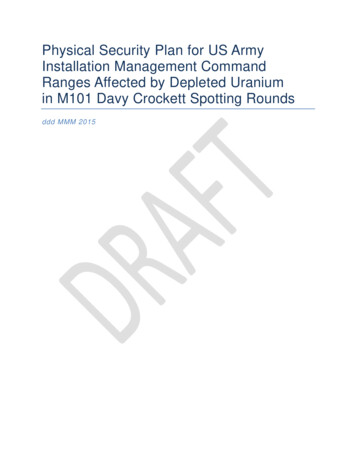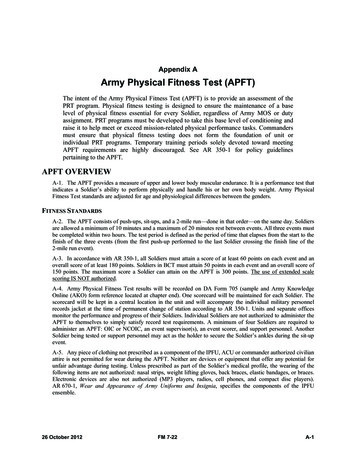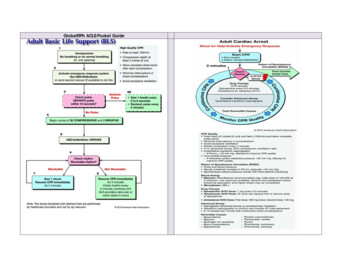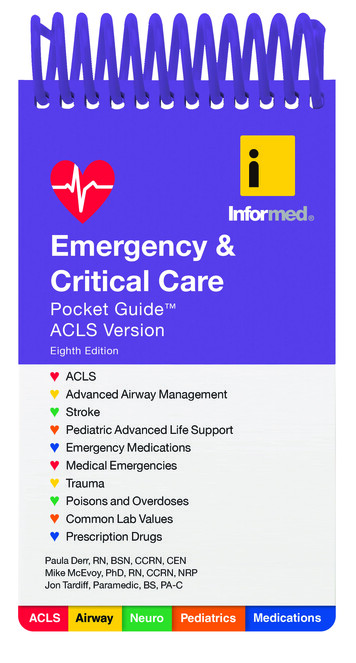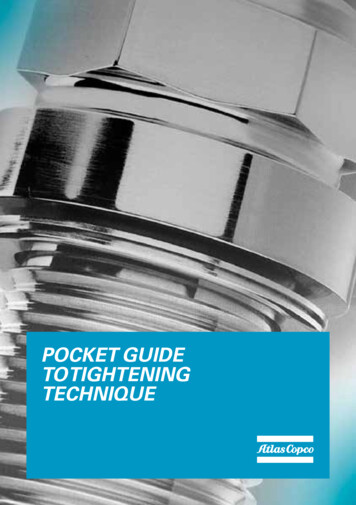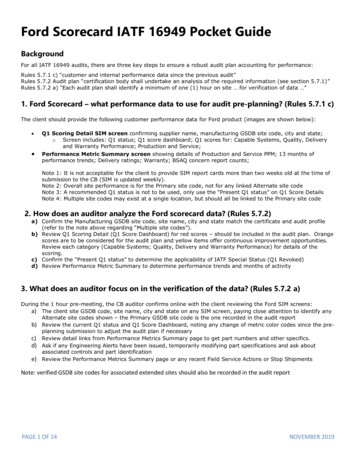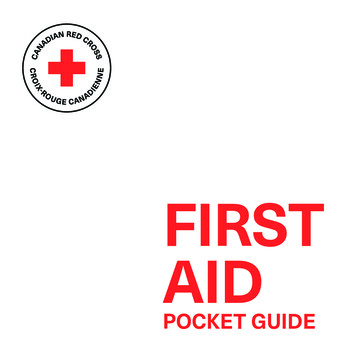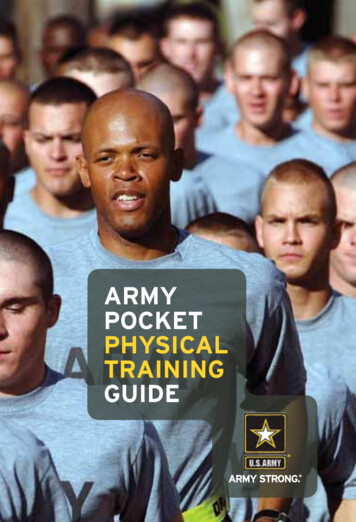
Transcription
ARMYPOCKETPHYSICALTRAININGGUIDE
Pocket Physical Training GuideThis publication contains the following information:IntroductionStandardized Physical Training SessionWarm–up Exercise DrillsStandardized Physical Training ActivitiesStandardized Cool–downRunningCalisthenicsStability Training4 for the Core (4C)Hip Stability Drill (HSD)Conditioning Drill 1 (CD1)Military Movement Drill (MMD)Stretch Drill (SD)Conditioning Drill 2 (CD2)Conditioning Drill 3 (CD3)Training SchedulesCONTENTSGetting StartedSafety ConsiderationsInjury ControlShoesClothingEnvironmental ConditionsSigns and Symptoms of Heat InjuriesSigns and Symptoms of Cold Weather InjuriesHydrationNutrition
INTRODUCTIONINTRODUCTIONThe following information is provided for individuals preparing for thephysical demands of Initial Military Training (IMT). The staff of the U.S.Army Physical Fitness School (USAPFS) prepared this Pocket PhysicalTraining Guide. This document is the sole property of United States ArmyTraining and Doctrine Command (TRADOC) and is intended for use by U.S.Army Recruiters to assist future Soldiers.This guide was written in recognition that both the quality and quantityof physical activity recommended to the individuals using this guideis consistent with current physical activity recommendations for thegeneral public. The fitness components of Cardiorespiratory endurance,muscular strength and endurance, flexibility, and body composition areall inherent within this generalized exercise prescription. This programspecifies the intensity, duration, and frequency of training, and it is theinteraction of these three variables that results in improved health andphysical fitness.In order for this program to be safe and effective, it must be followed aswritten. Exercise must be conducted regularly at the proper intensity tobring about the desired changes in the body. However, changes in thebody occur gradually; so be patient and adhere to the program. If youmiss a session for some reason, just pick up where you left off with thenext day’s session. However, if you miss a whole week of sessions, youwill have to start the week over. In addition, following the nutritionalguidance in this document and ensuring adequate rest and recovery willoptimize health, improve physical fitness, and control injuries.DO NOT begin this physical exercise program before passing aroutine physical examination at the Military Entrance ProcessingStation (MEPS).
GETTING STARTEDYour physical training program will begin with an assessment ofyour present physical condition. Your Recruiter will administer anassessment (the 1–1–1 Physical Fitness Assessment), which consists ofone minute of push–ups, one minute of sit–ups, and a timed, one–milerun. This assessment will determine your starting point and appropriateplacement in the Pre–BCT Standardized Physical Training Program. Youand your Recruiter will review your scores to determine which trainingschedule you will follow. Commit to spending approximately 45 minutesper day, four to five times a week in the conduct of physical training.Whether you follow the walk–to–run guidelines or begin training ata higher level, this program will help prepare you for the physicalrequirements of IMT. If you follow this training program, you willexperience many of the health–related benefits of physical activity.Adherence to the Pre–BCT Physical Training Program begins yourpreparation for the successful completion of the IMT graduationrequirement to pass the Army Physical Fitness Test (APFT). This testconsists of two minutes of push–ups, two minutes of sit–ups, and atimed, two–mile run. Performance standards are based on age andgender.Safety ConsiderationsThe Pre–BCT Program is a safe and effective way to improve yourphysical fitness. To achieve these results, it must be followed as written. ALWAYS perform the prescribed warm–up and cool–down before andafter the training activity. Perform ONLY the prescribed number of sets and repetitions on thetraining schedule.
Proper form (precision) is more important than the sloppy executionof more repetitions. Perform ALL the exercises in the order listed for each drill. If you miss a day of training, pick up with the next day of thetraining schedule. Exercise with a training partner whenever possible.Although a little muscle soreness is to be expected when beginning anew physical training program, do not aggravate injuries by continuingto exercise when you are feeling pain or discomfort.Injury ControlInjuries are not uncommon during intense physical training. Mostinjuries can, however, be prevented. Safety is always a major concern.Many common injuries are caused by overuse, that is, exercising toomuch and too often and with too rapid an increase in the workload.Most overuse injuries can be treated with rest, ice, compressionand elevation.The most common running injuries occur in the feet, ankles, knees andlegs. Although they are hard to eliminate, much can be done to keepthem to a minimum. Preventive measures include proper warm–up andcool–down. Failure to allow recovery between hard bouts of running canlead to overtraining and can also be a major cause of injuries. If youexperience continuing or acute pain, see your doctor.GETTINGSTARTED
ShoesProper footwear may play a role in injury prevention. Choosing a runningshoe that is suitable for your particular type of foot can help you avoidsome common running–related injuries. It can also make running moreenjoyable and help you get more mileage out of your shoes. Always tie and untie shoes when putting them on and takingthem off. Expect shoes to be comfortable when you try them on. If they arenot, then do not buy them. How a shoe looks is not as important as proper fit or comfort. Replace running shoes when they begin to show visible wear orafter 500 miles of use, whichever occurs first. The best shoe for you may not be the most expensive. Alwaystry on both shoes and walk around the store to ensure they fitbefore purchasing. If possible, shop for shoes at the end of the day instead of in themorning. Your feet swell from being in shoes and moving aroundall day.
ClothingProper clothing can also help prevent injuries. Ensure that you are wearing some sort of reflective material ifexercising during hours of low visibility. Clothes should be comfortable, light in color, and fit loosely inwarm weather. Clothing may be layered according to personal preference in coldweather and gloves or mittens and ear–protecting caps should beworn to prevent frostbite. Rubberized or plastic suits should NEVER be worn during exercise orthe physical assessments.Environmental Conditions Do not exercise in extremely hot or cold weather; try to find analternate indoor location to reduce the risk of heat or cold injuries. Avoid exercising near heavily traveled streets and highways duringpeak traffic hours. Avoid exposure to pollutants before and during exercise, if possible(including tobacco). In areas of high smog concentrations, train early in the day or laterin the evening. Use a waterproof or sweat proof sunblock when exercising in warmweather to avoid sunburn. Follow the instructions on the bottle forproper use.GETTINGSTARTED
Signs and Symptoms of Heat InjuriesIf you experience any of the below symptoms of heat cramps, heatexhaustion, or heatstroke, immediately stop your physical activity.Heat CrampsMuscular TwitchingCrampingMuscular Spasms in Arms, Legs or AbdomenHeat Exhaustion (Requires Medical Attention)Excessive ThirstFatigueLack of CoordinationIncreased SweatingCool/Wet SkinDizziness and/or ConfusionHeatstroke (MEDICAL EMERGENCY, DIAL 911)No SweatingHot/Dry SkinRapid PulseRapid BreathingComaSeizureDizziness and/or ConfusionLoss of Consciousness
Signs and Symptoms of Cold Weather InjuriesDuring exercise in the cold, your body usually produces enough heat tomaintain its normal temperature. As you get fatigued, however, you slowdown and your body produces less heat. Hypothermia develops whenthe body cannot produce heat as fast as it is losing it.HypothermiaShiveringLoss of JudgmentSlurred SpeechDrowsinessMuscle WeaknessFrostbiteA white or grayish–yellow skin areaSkin that feels unusually firm or waxyNumbness in body parts exposed to the cold such as the nose, ears,feet, hands, and skinHydrationWater is the preferred hydration fluid before, during and after physicaltraining activities in the Pre–BCT program. Drink 13 to 20 ounces of cool water at least 30-60 minutes beforebeginning exercise (approximately 2 glasses of water). After the activity, drink to satisfy thirst, then drink a little more. After exercise, avoid alcoholic beverages and soft drinks becausethey are not suitable for proper hydration and recovery. Sportsdrinks may be consumed, but are not required and contain aconsiderable number of additional calories. It is also possible to drink too much water. Be sure to limit intake toNO MORE THAN 1 1/2 quarts per hour (48 oz.) during heavy exertion.GETTINGSTARTED
NutritionIn addition to exercise, proper nutrition plays a major role in attainingand maintaining total fitness. Good dietary habits greatly enhanceyour ability to perform at your maximum potential. A good diet alone,however, will not make up for poor health and exercise habits.Your body needs carbohydrates, protein, some fat, vitamins, minerals,fiber, and water to be healthy and grow strong. Include foods from eachof the main food groups in your diet to get all the nutrients you need.Bread, Cereal, Rice, and PastaWhat do you get? Carbohydrate, vitamins, minerals, fiber, and a smallamount of protein.Try to make at least half of your choices whole–grain products, suchas 100 percent whole grain bread, brown rice or wild rice, barley,or oatmeal.VegetablesWhat do you get? Carbohydrate, vitamins, minerals, fiber, and asmall amount of protein.Eat lots of different ones — at least 3 to 5 servings a day, especially deepgreen types and the red, yellow, and orange varieties.FruitWhat do you get? Carbohydrate, vitamins, minerals, and fiber.Eat all varieties — at least 2 a day. Try to have a citrus fruit or juice (forexample orange or grapefruit) plus a blue, red, purple, or orange type(such as blueberries, strawberries, plums or peaches) every day.
Milk, Yogurt, and CheeseWhat do you get? Protein, carbohydrate in milk and yogurt, vitamins, andminerals (especially calcium).Select 1 percent or nonfat milk or cottage cheese, nonfat or low–fatyogurt and part–skim or fat–reduced cheeses.Meats, Poultry, Fish, Eggs, Nuts, Dry BeansWhat do you get? Protein, vitamins and minerals (especially iron andzinc) plus carbohydrate in beans.Choose lean meats (ones with the words “round,” “loin,” or “leg” in thename), skinless chicken or turkey breast, ham, any fish or seafood (if notfried or in butter), egg whites, and veggie burgers.Fats, Oils, and SweetsWhat do you get? Mostly extra calories.A little is all right, but it’s easy to get too much. Cut way back on fried,greasy, oily, creamy, and buttery foods. Limit high–sugar, nutrient poorfoods like candy, desserts, and sugar–sweetened soda pop and fruitdrinks to once in a while and in small amounts.GETTINGSTARTED
Nutrition Tips At least two–thirds of your plate should be covered with foods fromthe grains, vegetables, and fruits groups and no more than onethird should have a low–fat or lean protein source from the milk ormeat group. To lose weight, decrease calories while increasing exercise andactivity. You can decrease calories by decreasing portions andlimiting high–fat and high–sugar and nutrition–poor foods. To gain weight, slightly increase calorie consumption while startingyour resistance training program to gain muscle not fat. Avoid most fast foods and processed foods (such as burgers andsausage, chips, fries and other deep–fried foods, snack crackers,snack cakes, and pastries). Drink 8–10 glasses of water a day. Take a “food first” approach to achieving good health andperformance. If you feel you are unable to meet your nutritionalneeds through your diet, consider taking a daily multi–vitamin,multi–mineral supplement that contains no more than 100 percent ofthe Recommended Daily Allowance.If you have questions, consult a registered nutritionist or dietitian.
STANDARDIZED PHYSICAL TRAINING SESSIONA standardized physical training session consists of three essentialelements: warm–up, activity, and cool–down. These elements areintegrated to produce the desired training effect. More importantly,every standardized physical training session must have a specificpurpose. This purpose, to prepare you for the physical demands of IMT,follows a recommended rate of progression, specific to each individual’stolerance to the current level of training. There are three stages ofstandardized progression: initial, improvement, and maintenance.The initial conditioning stage includes light muscular enduranceactivities and moderate–level Cardiorespiratory endurance activitiesthat produce minimal muscle soreness and control injuries. This stageusually lasts up to four weeks and is dependent upon the individual’sadaptation to exercise. The duration of the main activity during theinitial stage will begin with approximately 15 to 20 minutes and mayprogress to 30 minutes. Individual goals are established by yourRecruiter early in your exercise program and are reflected in whereyou start in the training schedule. These goals are realistic and providepersonal rewards. The initial stage is the Walk–to–Run Program and themuscular strength and endurance sessions conducted in weeks onethrough four.The goal of the improvement stage is to provide a gradual increase inthe overall exercise stimulus to allow for more significant improvementsin your fitness level. As an example, you will exercise at a moderateto vigorous intensity for 20 to 30 minutes continuously. This is shownthrough the increased running times in the running progression andthe incr
Calisthenics Stability Training 4 for the Core (4C) Hip Stability Drill (HSD) Conditioning Drill 1 (CD1) Military Movement Drill (MMD) Stretch Drill (SD) Conditioning Drill 2 (CD2) Conditioning Drill 3 (CD3) Training Schedules CONTENTS. INTRODUCTION The following information is provided for individuals preparing for the physical demands of Initial Military Training (IMT). The staff of the U.S .
